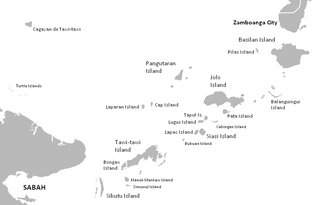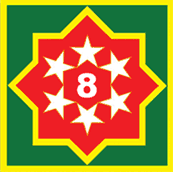
The Moro Islamic Liberation Front is an Islamist group based in Mindanao, Philippines, which sought an autonomous region of the Moro people from the central government. The group has a presence in the Bangsamoro region of Mindanao, the Sulu Archipelago, Palawan, Basilan, and other neighbouring islands. The armed wing of the group was the Bangsamoro Islamic Armed Forces (BIAF), although the name of its parent organization, the MILF, was often used to refer to the BIAF.

The Sulu Archipelago is a chain of islands in the Pacific Ocean, in the southwestern Philippines. The archipelago forms the northern limit of the Celebes Sea and southern limit of the Sulu Sea. The Sulu Archipelago islands are within the Mindanao island group, consisting of the Philippines provinces of Basilan, Sulu, and Tawi-Tawi; hence the archipelago is sometimes referred to as Basulta, derived from the first syllables of the three provinces.

The Philippine Scouts (Filipino: Maghahanap ng Pilipinas/Hukbong Maghahanap ng Pilipinas) was a military organization of the United States Army from 1901 until after the end of World War II. These troops were generally Filipinos and Filipino-Americans assigned to the United States Army Philippine Department, under the command of American commissioned officers (though a handful of Filipino Americans received commissions from the United States Military Academy). Philippine Scout units were given the suffix "(PS)", to distinguish them from other U.S. Army units.

Operation Enduring Freedom – Philippines (OEF-P) or Operation Freedom Eagle was part of Operation Enduring Freedom and the global War on Terror. The Operation targeted the various Jihadist terror groups operating in the country. By 2009, about 600 U.S. military personnel were advising and assisting the Armed Forces of the Philippines (AFP) in the Southern Philippines. In addition, by 2014, the CIA had sent its elite paramilitary officers from their Special Activities Division to hunt down and kill or capture key terrorist leaders. This group had the most success in combating and capturing Al-Qaeda leaders and the leaders of associated groups like Abu Sayyaf.

Jolo is a volcanic island in the southwest Philippines and the primary island of the province of Sulu, on which the capital of the same name is situated. It is located in the Sulu Archipelago, between Borneo and Mindanao, and has a population of approximately 500,000 people.

The Moro conflict was an insurgency in the Mindanao region of the Philippines which involved multiple armed groups. A decades-long peace process has resulted in peace deals between the Philippine government and two major armed groups, the Moro National Liberation Front (MNLF) and the Moro Islamic Liberation Front (MILF), but other smaller armed groups continue to exist. In 2017, the peace council settled around 138 clan conflicts.

The First Battle of Bud Dajo, also known as the Moro Crater Massacre, was a counterinsurgency action conducted by the United States Army and Marine Corps against the Moro people in March 1906, during the Moro Rebellion in the southwestern Philippines.
The Ilagâ is a Christian extremist paramilitary group based in southern Philippines. The group is predominantly composed of Ilonggos, embracing a form of Folk Catholicism that utilizes amulets and violence.

The 8th Infantry Division, Philippine Army, known officially as the Storm Trooper Division, is one of the Philippine Army's Infantry units in the Visayas and under the AFP Central Command, combating local communist insurgent units, and terrorists.

Delfin C. Castro was a major general of the Armed Forces of the Philippines. He was the commander of the AFP Southern Command (SOUTHCOM), from 1981 to 1986. Notable incidents during his tenure include the Pata Island massacre, the assassination of Zamboanga City Mayor Cesar Climaco, the rescue of kidnapped Bishop Federico O. Escaler from Muslim rebels and the strafing of the Japanese vessel Hegg by Philippine Air Force fighters off Mindanao.
The 1995 Ipil massacre occurred on the morning of April 4, 1995, in the municipality of Ipil, then in Zamboanga del Sur province of the Philippines, when approximately 200 heavily armed Abu Sayyaf militants fired upon residents, strafed civilian homes, plundered banks, took up to 30 hostages and then burned the center of the town to the ground.

Emmanuel Trinidad Bautista is a Filipino general who served as the 44th Chief of Staff of the Armed Forces of the Philippines as he succeeded Gen. Jessie Dellosa as AFP Chief. He served as the Executive Director of the Cabinet Cluster on Security, Justice, and Peace at the Office of the President, Malacañang. His appointment as Undersecretary at the Office of the President was from 1 September 2014 to 22 June 2020 shortly after retirement from the military service as Chief of Staff, Armed Forces of the Philippines. Concurrently, he headed the National Task Force on the Whole of Nation Initiative and was also the executive Director of the National Task Force on the West Philippine Sea. He was succeeded by Gregorio Pio Catapang as AFP chief.

The Zamboanga City crisis or Zamboanga Siege was an armed conflict in Zamboanga City, Philippines between the government forces of the Philippines and Moro rebels from the Moro National Liberation Front (MNLF) that began on September 9, 2013 and ended twenty days later on September 28. The conflict began when MNLF rebels, under the command of Nur Misuari, attempted to occupy several coastal communities in Zamboanga City in protest of the Philippine government's failure to implement the 1996 final peace agreement with the MNLF.
The Malisbong Masjid or H. Hamsa Tacbil Mosque massacre, also called the Palimbang massacre, was the mass murder of Muslim Moros by units of the Philippine military on September 24, 1974, in the coastal village of Malisbong in Palimbang, Sultan Kudarat, Mindanao. Accounts compiled by the Moro Women's Center in General Santos state that 1,500 male Moros aged 11–70 were killed inside a mosque, 3,000 women and children aged 9–60 were detained – with the women being raped – and that 300 houses were razed by the government forces. The massacre occurred two years after Ferdinand Marcos declared martial law in September 1972.

The history of the Philippine Army began in during pre-colonial era as different tribes established their own citizen force to defend the Balangays from intruders. Army was organized forces through the years who fought Spanish oppression and even other invaders such as Dutch and British who attempted to conquer the Philippines in early centuries.
The battle of Jolo, also referred to as the burning of Jolo or the siege of Jolo, was a military confrontation between the Moro National Liberation Front (MNLF) and the government of the Philippines in February 1974 in the municipality of Jolo, in the southern Philippines.

The Patikul massacre refers to an event that took place on October 10, 1977 in Patikul, Sulu province in the Philippines. Thirty-five officers and men of the Philippine Army were killed by elements of the Moro National Liberation Front under Usman Sali. Among the dead were Brigadier General Teodulfo Bautista, commanding general of the 1st Infantry Division, Adjutant General of the Armed Forces of the Philippines, Col. Gabriel Pangilinan and four lieutenant colonels.

Delfin Negrillo Lorenzana, OLH, KGOR is a retired Philippine Army general who served as Chairman of the Bases Conversion and Development Authority from 2022 until September 2024. He previously served as Secretary of National Defense in the Cabinet of President Rodrigo Duterte from 2016 to 2022. He served in the Philippine Army from 1973 to 2004.

The 2000 Philippine campaign against the Moro Islamic Liberation Front was a military campaign conducted by the Armed Forces of the Philippines (AFP) against a Muslim secessionist group that took place during the presidency of Joseph Estrada in the Autonomous Region in Muslim Mindanao in the Philippines. The campaign was waged "to weaken the Moro Islamic Liberation Front's capability to undermine the territorial integrity of the Philippines and inflict harm on both government personnel and civilians".
The dictatorship of 10th Philippine president Ferdinand Marcos in the 1970s and 1980s is historically remembered for its record of human rights abuses, particularly targeting political opponents, student activists, journalists, religious workers, farmers, and others who fought against his dictatorship. Based on the documentation of Amnesty International, Task Force Detainees of the Philippines, and similar human rights monitoring entities, historians believe that the Marcos dictatorship was marked by 3,257 known extrajudicial killings, 35,000 documented tortures, 737 'disappeared', and 70,000 incarcerations.















